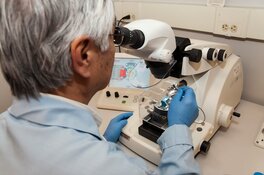The Life Sciences Report: I can still remember that October morning in 2006 when I heard on National Public Radio that you and Andrew Fire had won the Nobel Prize for your discovery of RNA interference (RNAi)—gene silencing by double-stranded RNA. I have always believed that this technology would be momentous for medicine. How did becoming a Nobel laureate change things for you?
Craig Mello: The best thing about the Nobel, for me, is that it has given me an opportunity to do more community outreach, especially trying to inspire kids with what fun it is to do science. Quite honestly, in the first two years after I got the prize I didn't get a whole lot of work done, because I didn't know how to say no and I was on the lecture circuit. I gave about 100 lectures a year for those two years. But I really enjoy speaking to lay people about science because it energizes me. I get so much out of it. The comments you get from people make you look back at what you've been taking for granted and say, "Wow, that is pretty cool." I enjoy that. I didn't have much of an opportunity to do that kind of lecturing prior to the prize. Now I could do it 24/7 if I wanted.
TLSR: Could you talk about double-stranded (RNAi) versus single-stranded (antisense) gene silencing? When I've discussed this topic over the years with Isis Pharmaceuticals Inc. (ISIS:NASDAQ) Chairman and CEO Stan Crooke, he says, "It's all antisense." Care to comment on that?
CM: Double-stranded and single-stranded oligonucleotides basically function through base pairing with target sequences. So, as Stan says, they really are all antisense at the final level. The difference is that double-stranded RNA enters into a cellular pathway where it's actively processed by the cell, and is loaded onto cellular machinery that is essentially a search engine for the cell. Our discovery was so surprising because we found that when we put double-stranded RNA into a cell, we were not only giving the drug, which is the antisense strand, but also, essentially, the antidote at the same time. The duplexed RNA should, in principle, be incapable of base pairing with anything, since it is already very efficiently base paired with itself.
"The genomics revolution really is happening. It's unfolding in laboratories around the world. People just need to be patient."
The way that an antisense technology works is that you introduce a single strand. That strand finds, through base-pairing interactions, a target, and then wraps around it and interferes with the function of that target. But, in the RNAi pathway, the double-stranded RNA is first acted on by the cell through a number of steps that lead to the separation of the two strands and the loading of enzymes called argonautes, which then help present the now single-stranded RNA for base pairing. Argonautes can do so more efficiently than an RNA strand can by itself. They facilitate the base-pairing interactions and speed up the search for a complementary sequence in the cell.
TLSR: In the antisense world, the single-strand molecule can modify protein synthesis, not just inhibit synthesis. I'm thinking of Sarepta Therapeutics Inc.'s (SRPT:NASDAQ) phase 2 candidate for Duchenne muscular dystrophy, eteplirsen, a single-stranded oligonucleotide that modifies the synthesis of dystrophin and produces a shorter protein that is actually functional. Isis Pharmaceuticals has a phase 2 candidate, ISIS-SMNRx, that does not inhibit but rather increases production of a protein, and it's being tested in spinal muscular atrophy. Can double-stranded technology modify protein synthesis, not just inhibit it?
CM: You mean, like to skip exons? No, to my knowledge RNAi has not been used for that. Off the top of my head, I can't think of an easy way that you could use an argonaute loaded with a small RNA to directly induce exon skipping. It's an interesting question, but I don't know of any literature suggesting that it's possible to do that with RNAi. But it might be worth looking into.
There are a few studies showing that you can induce exon skipping indirectly by inhibiting certain components involved in the normal messenger RNA (mRNA) splicing machinery. This does not lead to skipping a single exon, but instead can globally alter exon inclusion in hundreds of mRNAs.
TLSR: What about moving oligonucleotides across a cell membrane? It seems like it would be easier to get a single strand through a cell membrane than a double strand. What is your thought?
CM: That is actually, as you know, a major bottleneck for RNAi therapeutics. They are big molecules, and they are charged, and they don't like to go through membranes. The reality is that this is a difficult platform, regardless of the type of oligonucleotide therapy you're contemplating, double- or single-strand. What's really terrific about RNAi is that once it's inside the cell, it enters very efficiently into the cellular machinery. However, we do know from thousands of experiments over the last 10 years or so that the overwhelming majority don't get in, and do not enter into the enzymatic machinery. There are bottlenecks that we don't understand.
"Our discovery was so surprising because we found that when we put double-stranded RNA into a cell, we were not only giving the drug, which is the antisense strand, but also, essentially, the antidote at the same time."
Oligonucleotide therapies are clearly limited by delivery. Everybody knows that is a major problem, and it does apply to both types of oligos. For some types of tissue we can get delivery. With antisense technology, the single-stranded version—Isis' version—you use a very high dose, and in some cases, because of toxicity, it's a lot higher than you would prefer. We worry about improving delivery for all of these technologies. A lot of research is going into that area.
On the other hand, quite surprisingly—and I would add that I think this is fascinating—many organisms, including the nematode worm Caenorhabditis elegans (C. elegans) that Andrew Fire and I worked on, can seemingly actively transport double-stranded RNA. There is growing awareness now that, in humans, a lot of oligonucleotides are actually in circulation in the blood. There is a growing interest in natural mechanisms that are involved in transporting oligonucleotides in and out of cells. This is a very active area of research.
TLSR: I have been doing some diligence on DNA vaccines. One company, Inovio Pharmaceuticals Inc. (INO:NASDAQ), is using electroporation—an electrical pulse—to get plasmids into cells. It seems to be working because the cells are synthesizing antigens encoded by the DNA. Is electroporation something you've worked with and thought about?
CM: Sure. Many years ago, I tried electroporation to deliver DNA into the nematode. Basically, you're using electric shock to disrupt membranes and to get big molecules—in this case RNA, or even DNA—to go across the membrane. It's a viable route for local delivery, and you certainly can electroporate oligonucleotides, even into human tissue. I'm not sure it's a very pleasant experience for the person who's getting electroporated, but I do think it should be possible to do that.
Many people use electroporation in the laboratory to deliver RNAi into model systems, and it works beautifully. Again, some delivery strategies, such as electroporation, work wonderfully in the laboratory but are hard to translate into a human setting. I don't know of anyone using that approach successfully with RNAi, or anyone contemplating clinical applications of RNAi that way. As I've said, there is a lot of work to do in the area of delivery.
TLSR: At least for the time being, would you say that there are needs for both double-stranded and single-stranded technology?
CM: Absolutely. There are niches for all of these technologies.
In many ways, the single-stranded (antisense) technologies are more mature. They've been around longer in some cases, and they are somewhat better understood in terms of how they work. I think they are very viable approaches, and there are plenty of opportunities for all of types of oligonucleotide therapies to coexist and produce excellent clinical applications in their own, particular settings.
"What's really terrific about RNAi is that once it's inside the cell, it enters very efficiently into the cellular machinery."
For instance, I think antisense technology is very attractive as an anti-microRNA approach. These microRNAs are the cellular endogenous RNAi machinery that is regulating many genes involved in a whole variety of processes. You name it: Nearly every physiological function in the human has a microRNA involved. They're fairly ubiquitous regulators of development, and are often implicated in disease. There may be value therapeutically in knocking down the activity of microRNAs with antisense technologies, which are very well suited to that type of application.
TLSR: You bring up an interesting point here with microRNAs. Again, initial research into microRNAs was done in C. elegans. We know that a single microRNA can inhibit dozens to hundreds of messenger RNAs, and prevent them from synthesizing their protein. It's a natural form of antisense, or RNAi, as you put it. There must be an evolutionary basis for these mRNA genes being related in their function. If we're dealing with genetic disease, microRNAs seem like a tremendous pathway to follow to find out what all these different genes have in common, since one microRNA can control so many mRNA genes.
CM: Certainly, microRNAs are important regulators inside the cell. Interestingly, they have been implicated now in major diseases, where their misregulation is, at least in part, an underlying cause. Most striking examples are in cancer, where there are tumor suppressor microRNAs. There are also oncogenic microRNAs, which cancer cells find ways of turning on inappropriately.
As you can imagine, these are very interesting targets for clinical applications in cancer therapy. If you can inhibit the function of an oncogenic microRNA, you could potentially have a beneficial effect. As you pointed out, because microRNA regulate many genes, it can strongly influence many different aspects of the cellular phenotype. You can also contemplate strategies where you would replace a microRNA function that's missing by putting in a mimic of the microRNA. Again, once we solve the delivery issue, microRNA become much more attractive targets.
TLSR: Let's continue with that bottleneck theme for a moment, and discuss how it might be overcome. Can you tell me a little bit about the next-generation platform at RXi Pharmaceuticals Corp. (RXII:OTCQX)? You are a founder and currently on the scientific advisory board of the company. Tell me what you can about RXi's self-delivering (sd) rxRNA platform?
CM: I can tell you that when we founded RXi, much of our thinking was directed at the problem of delivery. How were we going to make RNA molecules that would pass into cells more readily? There are various approaches: You can complex these oligos with other factors, like proteins, or you can envelop them in lipid bilayers, or into nanoparticles and try to get them into cells that way. The thing that's really nice about the sd-rxRNA platform is that it's a relatively simple strategy compared to those others.
"A lot of pharmaceutical companies, especially the oligonucleotide-pharmaceutical-biotech companies, shoot for the stars and hope that the blockbuster indication is its first target."
What we've done at RXi is modify the RNA itself to make it more druglike, which improves its ability to penetrate cell membranes. The result is spontaneous cellular uptake of sd-rxRNA without having to complex it into a large particle to get it into a cell. This work is based on that of—and a lot of it published by—Dr. Anastasia Khvorova, who was the chief scientific officer at RXi until 2012, and before that worked with Dharmacon Inc. (a subsidiary of Thermo Fisher Scientific Inc. [TMO:NYSE]). The platform is the summation of many different chemical modifications. Some of them are described on the website, where the company has made that information available. The platform basically allows the RNA to enter cells much more readily than would a typical short-interfering RNA (siRNA). In fact, the uptake is really striking. Within minutes, you can see cells exhibiting substantial uptake of a fluorescently labeled sd-rxRNA, whereas a control RNA, without sd-rxRNA properties, would basically just not get into the cell at all.
TLSR: Is the problem solved? What are the limitations?
CM: The thing that limits sd-rxRNA is that you have to directly deliver it into a tissue. It doesn't work by itself very well in serum—so far, anyway—so it needs to go directly into the tissue where it's going to function. The problem of getting a therapy to function more systemically is common to all RNAi, and will require additional improvements in the technology. But right now, when you put sd-rxRNA on cells, it gets into them very rapidly. A good percentage of the self-delivering molecules will then enter the cellular machinery and begin searching for targets and silencing them. In my opinion, it's probably one of the best, if not the best, self-delivering RNAi platform that's out there.
TLSR: Is this sd-rxRNA technology platform entered into human trials as yet?
CM: Yes. RXi Pharmaceuticals has its anti-scarring compound RXI-109 in the clinic now.
TLSR: How does that work? What is the target there?
CM: The target is connective tissue growth factor (CTGF) in post-surgical scarring. CTGF is a hormone released by cells in response to injury. It promotes both healing and scarring. This is an application where reducing activity, not eliminating activity, is the goal. The hope is that reducing CTGF expression could prevent excessive deposition of scar tissue without impeding the natural healing process.
Scarring can be debilitating in some cases. Preventing scarring at an incision point in the skin following surgery could help maintain a person's freedom of movement of a limb. There are many other applications for an anti-scarring therapy as well, including promising ocular indications.
TLSR: Did the company start with this indication because you get scarring in areas where you have direct access—where you can get to the tissue and inject sd-rxRNA directly?
CM: Exactly. I think a lot of pharmaceutical companies, especially the oligonucleotide-pharmaceutical-biotech companies, shoot for the stars and hope that the blockbuster indication is its first target. I think RXi Pharmaceuticals, very wisely, chose a target where delivery for the compound was guaranteed. That's an obvious necessity if you want to have a clinical effect. You have to be able to get delivery into the target cells. The skin is a great target for these types of molecules.
TLSR: Craig, are there other companies that you think are interesting in antisense or RNAi?
CM: Yes. There are various partial solutions to the delivery issue that look like they're good enough to succeed in the clinic, but may not be the blockbuster new drug platform that everybody was talking about back in the early 2000s. We're still a ways away from that.
"Even though there are no approved RNAi therapies yet, there have been many breakthroughs in laboratories, where new functions or new insights into potential therapeutic avenues have been uncovered."
For one, I see a lot of good things coming from Alnylam Pharmaceuticals Inc. (ALNY:NASDAQ). I'm particularly supportive of the company's efforts to develop therapeutics for orphan diseases affecting liver and blood disorders, where its RNAi formulations have a good shot at significant delivery. I'm also seeing some interesting indications for the locked nucleic acids approach. Santaris Pharma A/S (private) is the company that owns that approach. Its pipeline looks very promising, and I know a lot of the company's programs are working their way into clinical trials now. There are definitely going to be some interesting new drugs coming down the pike. I hope that they make it all the way into the clinic. It would be wonderful to see some real impact in the clinic.
TLSR: Where has RNAi had its biggest impact?
CM: I often get asked that question. Right now, and over the last 10, even 12, years, RNAi's biggest impact has been in the laboratory, where it allows us to go from genes that may be expressed or whose expression may be altered in disease to a very rapid understanding of how those genes function and what pathway those genes function in. Even though there are no approved RNAi therapies yet, there have been many breakthroughs in laboratories, where new functions or new insights into potential therapeutic avenues have been uncovered using the RNAi approach. That's going to continue to be a very important way that RNAi will help build pipelines in the pharmaceutical industry, and in clinical trials for new drugs that are not necessarily siRNA- or oligonucleotide-based at all. New targets are being discovered for small molecules whose identification as a target for a particular disease indication was made using RNAi. There are a lot of examples of that in the pipeline for new drugs.
The genomics revolution really is happening. It's unfolding in laboratories around the world. People just need to be patient.
TLSR: Craig, are there even newer technologies that look interesting to you right now? Anything you might mention?
CM: One of the newer technologies that came onto the scene last year is a technology called clustered regularly interspaced short palindromic repeats (CRISPR). I have to caution people that it's not ready for use in humans. But, again, much like RNAi, the CRISPR technology is a triumph of basic science. Are you familiar with this, George?
TLSR: I am not: Go ahead and tell me about it.
CM: The CRISPR technology is a fascinating example of basic science. Much like RNAi, the CRISPR system uses a nuclease that is guided by RNA, but this nuclease is guided to the DNA and cleaves the DNA. It's a bacterial immune system. Bacteria use it to prevent viral infection; they cleave up the DNA genome of the virus and can destroy it using this RNA-guided enzyme. It's a different enzyme than the argonautes, and it's not homologous to the argonaute.
But the thing that's amazing about CRISPR is that, even though it is a bacterial system in origin, it now has been shown to work in dozens of diverse organisms. Unlike RNAi, where all you have to do is provide the guide RNA and it gets loaded into the cell's own RNAi machinery, CRISPR works by providing an mRNA, or a piece of DNA that expresses the bacterial enzyme, and a guide RNA that gets loaded onto that enzyme. Then that goes into the nucleus, and can cut the genome wherever you want. There are companies starting up in the space already, because there are so many things you can do with the technology. You can modify the genomes of crop plants, animals, human cells in culture. There are many applications for this technology.
TLSR: Are you doing any work with CRISPR yourself?
CM: We're using it in the laboratory, just like hundreds and perhaps even thousands of laboratories around the world. It's already dramatically speeding up the kinds of experiments we can do. We're doing things now that we've always wanted to be able to do, but just couldn't. It is an amazing technology.
TLSR: I hope we can talk about that in the future. It was such a pleasure meeting you, Craig. Thank you.
CM: Thanks, George.
Dr. Craig C. Mello is an investigator at the Howard Hughes Medical Institute, the Blais University Chair in Molecular Medicine and codirector of the RNA Therapeutics Institute at the University of Massachusetts Medical School. Dr. Mello's lab uses the nematode C. elegans as a model system to study embryogenesis and gene silencing. His collaborative work with Dr. Andrew Fire led to the discovery of RNA interference (RNAi), for which they shared the 2006 Nobel Prize in Physiology or Medicine. Together they showed that when C. elegans is exposed to double-stranded ribonucleic acid—dsRNA, a molecule that mimics a signature of viral infection— the worm mounts a sequence-specific silencing reaction that interferes with the expression of cognate cellular RNAs. For the layperson, RNAi is the cell's search engine; the Google of the cell. RNAi allows researchers to rapidly "knock out" the expression of specific genes and to thus define the biological functions of those genes. RNAi also provides a potential therapeutic avenue to silence genes that contribute to disease. Before the Nobel Prize, Dr. Mello's work on RNAi was recognized with several awards, including the National Academy of Sciences Molecular Biology Award, the Canadian Gairdner International Award, the Paul Ehrlich and Ludwig Darmstaedter Award and the Dr. Paul Janssen Award for Biomedical Research. He is a member of the National Academy of Sciences, the American Academy of Arts and Sciences, and the American Philosophical Society. Read Dr. Mello's biographical sketch on the Nobel Foundation's website.
Want to read more Life Sciences Report interviews like this? Sign up for our free e-newsletter, and you'll learn when new articles have been published. To see a list of recent interviews with industry analysts and commentators, visit our Streetwise Interviews page.
DISCLOSURE:
1) George S. Mack conducted this interview for The Life Sciences Report and provides services to The Life Sciences Report as an independent contractor. He or his family own shares of the following companies mentioned in this interview: None.
2) The following companies mentioned in the interview are sponsors of The Life Sciences Report: RXi Pharmaceuticals Corp., Inovio Pharmaceuticals Inc. Streetwise Reports does not accept stock in exchange for its services or as sponsorship payment.
3) Dr. Craig Mello: I or my family own shares of the following companies mentioned in this interview: RXi Pharmaceuticals Corp. I personally am or my family is paid by the following companies mentioned in this interview: RXi Pharmaceuticals Corp. My company has a financial relationship with the following companies mentioned in this interview: None. I was not paid by Streetwise Reports for participating in this interview. Comments and opinions expressed are my own comments and opinions. I had the opportunity to review the interview for accuracy as of the date of the interview and am responsible for the content of the interview.
4) Interviews are edited for clarity. Streetwise Reports does not make editorial comments or change experts' statements without their consent.
5) The interview does not constitute investment advice. Each reader is encouraged to consult with his or her individual financial professional and any action a reader takes as a result of information presented here is his or her own responsibility. By opening this page, each reader accepts and agrees to Streetwise Reports' terms of use and full legal disclaimer.
6) From time to time, Streetwise Reports LLC and its directors, officers, employees or members of their families, as well as persons interviewed for articles and interviews on the site, may have a long or short position in securities mentioned and may make purchases and/or sales of those securities in the open market or otherwise.








































